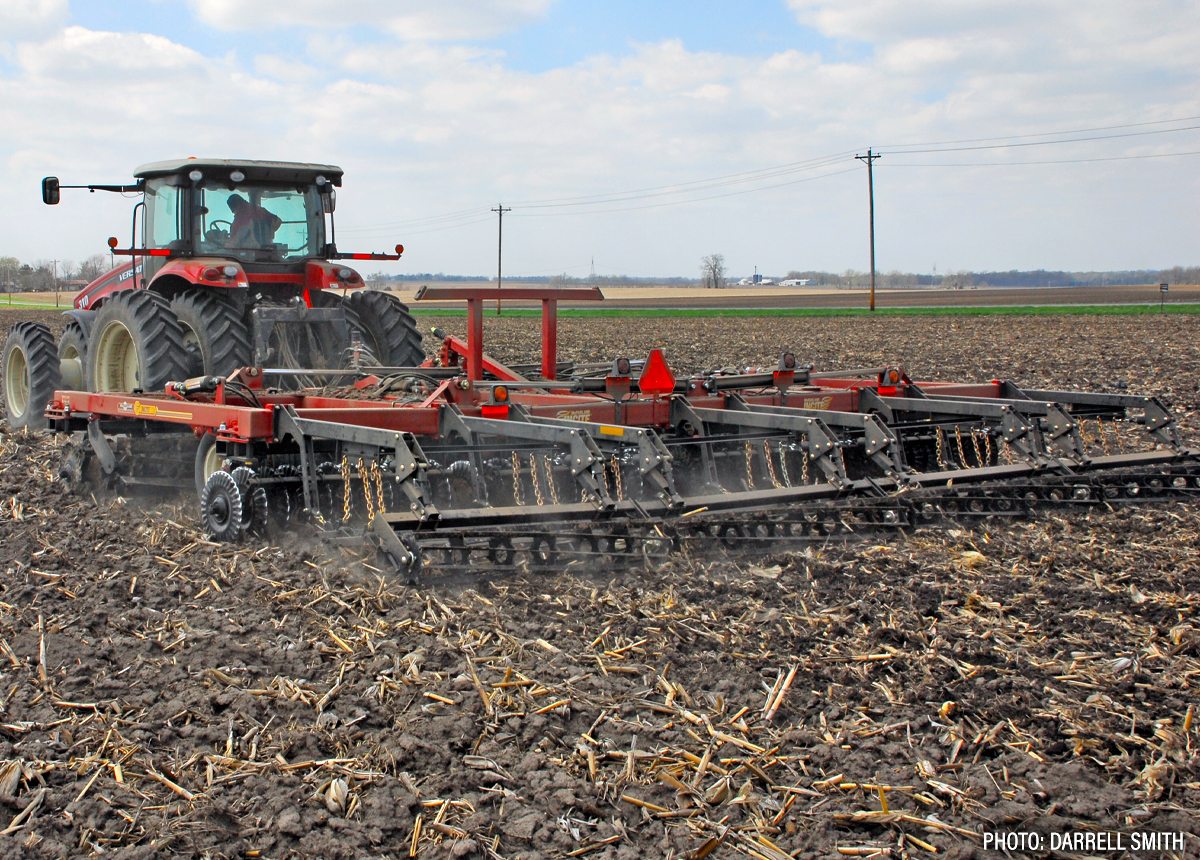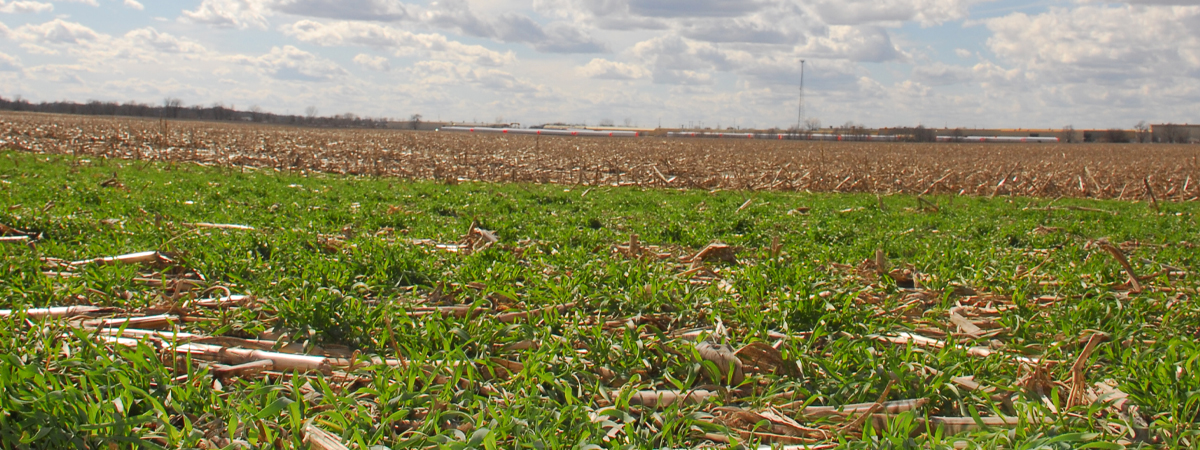Shatter Your Yield Barriers One Layer At A Time

Layers of dense or compacted soil will prevent vertical farming systems (no-till, strip-till and vertical tillage) from reaching their potential. That’s important in light of coming government incentives pushing you toward surface residue and cover crops.
So — you have probed or dug and found the layers put in place by horizontal farming tools. What’s next?
“Now it’s time to find the best way to remove them,” says Farm Journal field agronomist Ken Ferrie.
Here are some factors to consider:
1. Two goals: depth and shattering.
“If there are multiple layers from different horizontal tillage programs, such as moldboard plows, field cultivators and disks, focus on the deepest one,” Ferrie advises. “If you remove it, you’ll get rid of both.
“At the same time, we must get complete shattering of the top 4" to 6" of soil, across the width of our implement. That surface shattering creates a uniform environment for consistent seed depth, spacing and seed/soil contact. That’s the environment you get with horizontal secondary tillage tools, but their shearing action created the layer you’re now trying to remove. If your primary tool fails to shatter the surface, vertical harrowing can’t fix it because vertical harrows level from the surface, simply knocking peaks into valleys.”

Non-uniform shattering causes uneven crop growth, often showing up early in the season as streaking patterns at the angle you tilled.
“Areas between the shanks that aren’t shattered at the surface will be like no-till compared to the shattered areas,” Ferrie says. “Besides uneven growth, your operators will complain about the rough ride all season long. That rough surface will remain even after long-term no-till.”
2. Balance depth, spacing and horsepower.
Standard chisel plows might not work to remove deep layers. “To remove an 8" plow sole, it will need to run 10" or 12" deep,” Ferrie says. Better choices for 6" to 12" layers include in-line rippers, disk-rippers and what Ferrie calls hybrid chisels. Those chisels feature high clearance for deep tillage and residue flow, adjustable depth and gang angle for the front cutters, and multiple options and depth control for the leveling section on the rear.
But selecting the ideal tool is a balancing act. “As a rule of thumb, the depth you run needs to be half of the shank spacing, to get full-width shattering in the top 4" to 6" of soil,” Ferrie continues. “But the shanks also need to run about 2" to 3" deeper than the layer to remove as much of it as possible.
“So a hybrid chisel on 15" spacing must run 7½" deep for full shattering at the surface. That will work fine for layers that are 4” to 5” deep, but if the layer is 8" deep, and the shanks need to run 10" to 12" deep to remove as much of it as possible, a hybrid chisel will struggle to get deep enough.”
Avoid Recreational Tillage
Removing deep layers can take several years running the tool at different angles. “A disk ripper on 30" spacing with parabolic shanks also needs to go 12" deep to take out an 8" layer,” Ferrie says. “But you need 15" of depth to get full-width shattering at the surface. At that depth and spacing, growers often run out of horsepower and/or traction. If they shallow up and run the tool above the layer, they’re doing nothing but recreational tillage.
“Running shanks with wings will remove more of the layer,” Ferrie says. “But the wings must run below the layer. At that depth, growers often run out of traction and horsepower. Straight chisel points let you go deeper with the same amount of horsepower and traction, but the amount of layer they remove is reduced.”
Removing Layers with Strip-Till and Cover Crops
“A combination of strip-till and cover crops may help remove layers on highly erodible land where you are not allowed to till,” says Farm Journal field agronomist Ken Ferrie.
“Strip-tilling with a knife can break through shallow layers in the 4" range. Move the strips each year. Be careful if the field has much slope; rain can run across the soil surface into the strips, causing blowouts on steeper areas.”
Cover crops might be able to punch bio-channels through soil layers. “It depends how severe the layer is,” Ferrie says. “Often, covers cannot penetrate compact layers very well. I have found density layers after seven years of cover crops.”
Bio-channels from worms, night crawlers and roots will help maintain a vertical system, but they will develop much faster and deeper if you take the layers out before going vertical.

Residue Complicates Your Choices
If you wish to preserve surface residue to prevent erosion, or if your approved conservation plan requires it, that further complicates the task of layer removal. Some options include:
- Some hybrid chisels designed for vertical systems can be set up with straight coulters in front, little or no changeable gang angle, cutters controlled separately from shank depth and with a leveling device on the rear — what some call a conservation chisel. “Running these tools through soybean stubble leaves some surface cover to protect soil in the spring,” says Farm Journal field agronomist Ken Ferrie. “Running them in corn stalks leaves enough residue that you can hardly tell anything was done.”

- In-line rippers, properly operated, are excellent for taking out deep layers while preserving surface cover. “On 30" spacing, run your in-line ripper 15" deep,” Ferrie says. “Keep it level and keep going deeper until the soil lifts evenly across the implement, from shank to shank. The soil should roll through the ripper like a wave. If it is blowing out around the shanks and not being lifted in between, you need to go deeper.”
- Ferrie recommends avoiding wings on ripper shanks. “They make the soil blow out more, covering the residue and leaving a rough surface,” he says. “They also increase horsepower and traction requirements, often causing operators to shallow up and not get full-width shattering of the surface layer.”
- Keep ripper shanks in line, rather than offsetting some of them. Offsetting will force you to run deeper and require more horsepower.
- In-line rippers are not the best choice for shallow layers. “Layers in the top 4" of soil will lift up and slide through the ripper like a sidewalk, settling back down into place,” Ferrie says. “If you run rippers too fast in these conditions, the surface will flip up like little gravestones. Ripping will help, but you’ll still have a layer, requiring several years to remove.”
- If you have both deep and shallow layers, use an in-line ripper in soybean stubble, removing the deep layer and leaving maximum residue, Ferrie suggests. “Come back the next year with a chisel in corn stalks, taking out what’s left of the shallow layer when you have more residue to work with.”
Interested in learning more about how to convert to a vertical farming system? Ken Ferrie shares more here.







